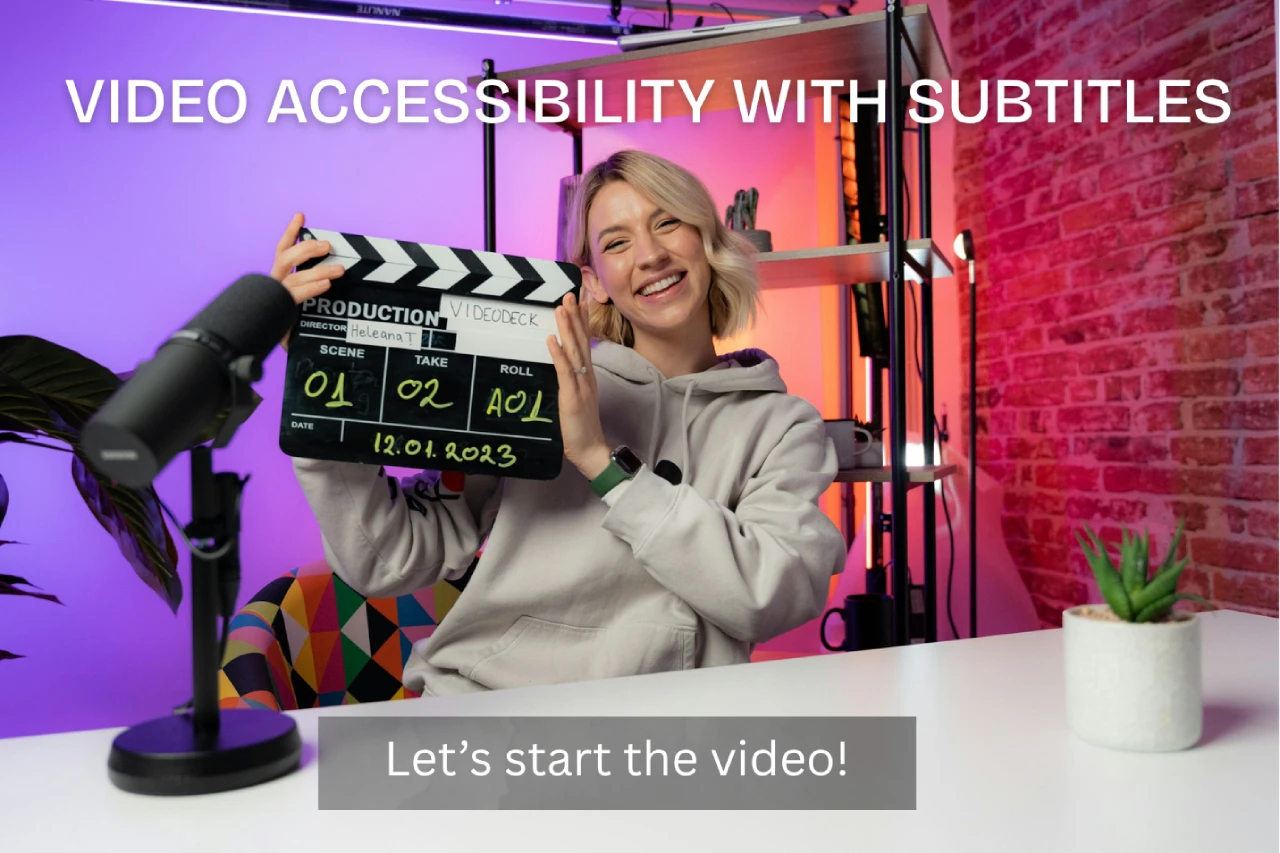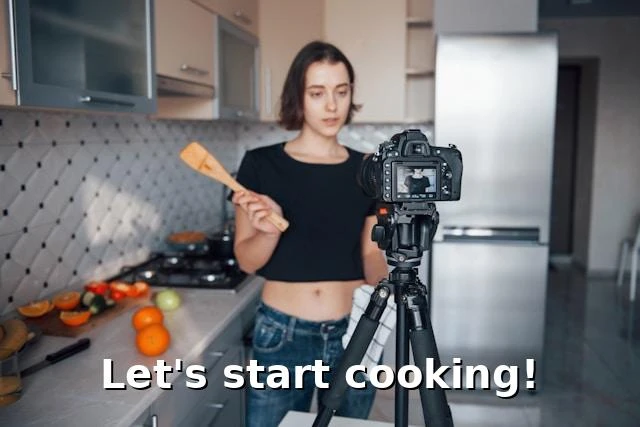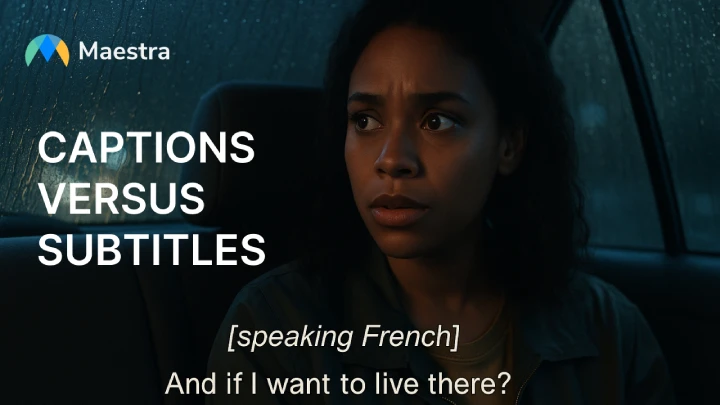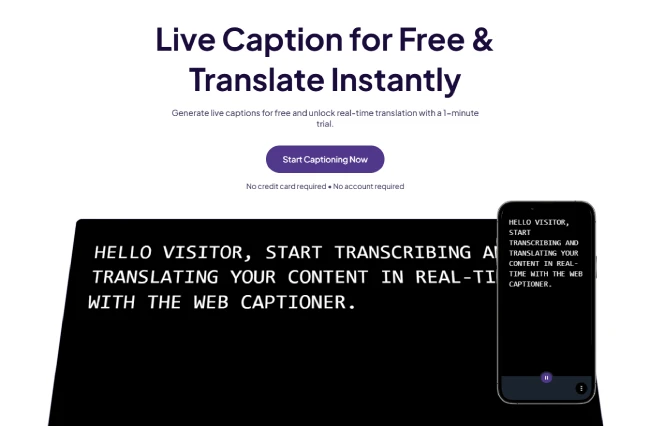How to Make Your Video Content Accessible with Subtitles

In the content game, making your content accessible isn’t just the right thing to do; it’s essential for audience growth, legal compliance, and user experience. Video accessibility and closed captions play a central role in ensuring that everyone, regardless of hearing ability or language fluency, can fully engage with your videos. Whether you're a content creator, educator, or business owner, adding subtitles and captions helps break down barriers and expands your reach.
Let’s explore how subtitles improve accessibility, the tools available to help you, and best practices to follow.
What is Video Accessibility?

Video accessibility is the practice of making video content usable by people with diverse needs, including individuals with disabilities. It’s about ensuring that no viewer is excluded due to hearing, language, or cognitive limitations.
At its core, video accessibility ensures that:
- People who are deaf or hard of hearing can follow along using visual cues like closed captions.
- Non-native speakers can comprehend dialogue through translated subtitles.
- Viewers with cognitive differences benefit from clear, structured video formats.
- Users in silent environments (e.g., libraries, offices, public transit) can still engage with your content.
This isn’t just a matter of convenience—it’s a matter of inclusivity. In many regions, it's also a legal requirement. Guidelines like the Americans with Disabilities Act (ADA), the Web Content Accessibility Guidelines (WCAG 2.1), and Section 508 all emphasize equal access to digital content, including video.
Subtitles vs. Closed Captions: What’s the Difference?

While they may appear similar, subtitles and closed captions serve different audiences and use cases.
Subtitles typically convey only the spoken dialogue and are intended for viewers who can hear the audio but may not understand the language being spoken. They are often used in foreign films, international content, or multilingual marketing.
Closed captions, on the other hand, are designed for accessibility. They not only display the spoken dialogue but also include non-speech audio elements such as sound effects, background music cues, speaker identification, and tone. Captions provide vital context that the viewer would otherwise miss without the ability to hear the audio.
For example:
- Subtitle: "Let's go to the park."
- Closed caption: [Child laughing] “Let’s go to the park,” [birds chirping]
For full accessibility, closed captions are essential—they’re the gold standard for inclusive video content.
Why Video Accessibility and Closed Captions Matter
1. They Expand Your Audience
Captions open the door to viewers with hearing impairments, who make up over 5% of the world’s population. But the reach doesn’t stop there. Studies show that over 80% of people who use captions are not hearing impaired. They're watching in environments where they can’t play audio, or they simply process information better when reading along.
Subtitles also cater to global audiences, making your content multilingual and borderless. For brands, this is an opportunity to connect with new demographics without producing additional content.
2. They Improve User Experience
Captions boost comprehension, retention, and focus. They support neurodivergent audiences by adding structure and clarity. For educational and corporate content, they increase learning outcomes and reduce the cognitive load on viewers.
Captions can also benefit those watching content in their second or third language—an increasingly common scenario in today’s globalized digital space.
3. They Support SEO and Content Discovery
When you add captions or transcripts, you’re embedding readable text that search engines can crawl. This improves indexing, boosts search rankings, and enhances visibility—especially for long-form video content. Captions also make your videos easier to find and share on social media platforms where silent autoplay is the default.
4. They Help You Stay Compliant
Failing to meet accessibility standards could result in lost audience trust, reputational damage, or even legal action. Governments, universities, and large enterprises are now required to make video content compliant with ADA or WCAG guidelines. Even small creators are being held to higher standards as platforms enforce accessibility policies.
How to Make Your Videos More Accessible with Subtitles and Captions
Adding subtitles and captions doesn't have to be complex or time-consuming. Today’s tools make it easier than ever—even at scale. Here’s a simplified breakdown:
First, you need a transcription of your spoken content. This can be done manually by listening and typing it out, or automatically using AI transcription tools. Once you have the text, it needs to be synced with your video’s timeline. This ensures captions appear on screen in perfect alignment with the speech and sounds.
Finally, you export the caption file in a format like .SRT, .VTT, or .SBV, which can be uploaded to platforms like YouTube, Vimeo, or Wistia. You can also burn captions directly into your video for platforms that don’t support toggling captions on/off.
But what if you need to create hundreds of videos, or you’re livestreaming an event? That’s where platforms like Maestra come in.
Effortless Accessibility with Maestra AI
If you're looking for a scalable, reliable, and multilingual solution for captioning, Maestra is built for exactly that.
This AI-powered platform takes the pain out of video accessibility by offering:
✅ Automatic Subtitles

Maestra generates highly accurate subtitles in over 125 languages. Simply upload your video and the platform will transcribe, translate, and subtitle your content with just a few clicks. You can review and edit the subtitles in an intuitive editor, and then export them or embed them in your video.
✅ Live Subtitles

Hosting a webinar, virtual event, or livestream? Maestra can generate real-time subtitles as your event unfolds. This is a game-changer for accessibility, particularly for large audiences or global conferences, and makes your live content as inclusive as your recorded videos.
Best Practices for Captioning and Subtitling
Even with great tools, thoughtful implementation matters. To get the most out of your captions, consider the following:
- Keep your text clear and readable. Use high-contrast fonts, a legible size, and avoid decorative typefaces.
- Don’t overcrowd the screen. Stick to two lines of text max, and time them properly.
- Translate thoughtfully. Avoid word-for-word translations when adding multilingual subtitles—context and nuance matter.
- Include non-verbal audio cues. [Laughter], [music intensifies], or [thunder] all help convey the full experience of your video.
Accessibility is about more than checking a box—it’s about creating content that respects, includes, and values every viewer.
Frequently Asked Questions
What is the purpose of accessibility and captioning in video editing?
The purpose of accessibility and captioning in video editing is to ensure that everyone—regardless of hearing ability, language proficiency, or cognitive differences—can fully understand and engage with video content. Captions and subtitles help break down communication barriers, making videos usable in silent environments and accessible to global audiences. They also support compliance with legal standards like the ADA and WCAG.
Is closed captioning an accessibility feature?
Yes, closed captioning is a key accessibility feature. It provides not only the spoken dialogue but also relevant non-verbal audio cues like music, sound effects, and speaker identification. This ensures that viewers who are deaf or hard of hearing receive the full context of the video, enabling an inclusive and equitable viewing experience.
What are video captions for accessibility?
Video captions for accessibility are on-screen text representations of audio content, designed to make videos understandable for people with hearing impairments and non-native speakers. They include both dialogue and meaningful sound descriptions, such as “[applause]” or “[door slams].” These captions help ensure that no one is excluded from the content due to audio limitations.
What is the role of captions in accessibility?
Captions play a crucial role in accessibility by enabling individuals with hearing loss, auditory processing disorders, or those in sound-sensitive environments to access and understand video content. They also enhance comprehension, focus, and retention for many users, including those who are neurodivergent or watching in a second language. Captions transform video into an inclusive communication tool.
What is an example of video accessibility?
An example of video accessibility is a webinar that includes real-time closed captions and sign language interpretation, allowing deaf and hard-of-hearing participants to follow the content live. Another example is a YouTube video that offers translated subtitles in multiple languages, making it understandable to a global audience regardless of their native tongue.
What are the best practices for captions accessibility?
Best practices for captioning include using clear, readable fonts in high-contrast colors, limiting captions to two lines, and synchronizing text accurately with the audio. Captions should include non-verbal sounds when relevant, and translations should prioritize meaning over word-for-word accuracy. Ensuring consistency and reviewing for errors also greatly improves the user experience.
Conclusion: Make Video Content Accessibility Your Competitive Advantage
Video accessibility isn’t just a technical requirement—it’s a strategic opportunity. By embracing subtitles and closed captions, you’re not only creating a more inclusive experience for all viewers, but also unlocking greater reach, engagement, and discoverability. Whether you're producing a cooking vlog, running a global webinar, or creating educational content, accessibility should be built into your workflow from the start.
With tools like Maestra AI, adding subtitles and captions has never been easier. You can streamline the process, support multiple languages, and ensure your content meets modern standards—without sacrificing speed or quality.
Inclusive content is powerful content. Make it accessible, and you’ll make it unforgettable.
